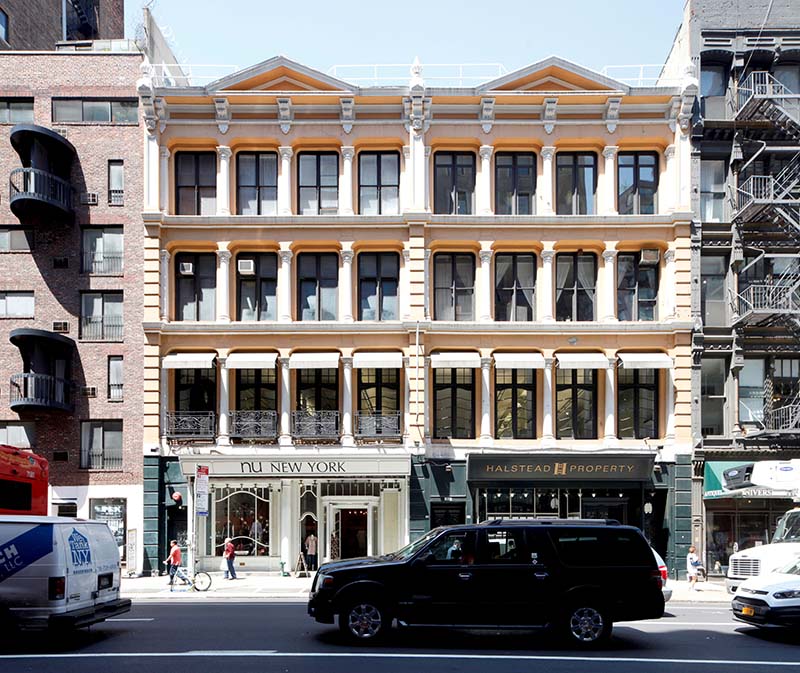
 Landmarks Preservation Commission311
Landmarks Preservation Commission311 Search all NYC.gov websites
Search all NYC.gov websites
Press Release
FOR IMMEDIATE RELEASE:
Tuesday, October 31, 2017
LANDMARKS PRESERVATION COMMISSION DESIGNATES 827 - 831 BROADWAY A LANDMARK

(New York, NY)- The New York City Landmarks Preservation Commission voted unanimously today to designate 827 and 831 Broadway in Manhattan as an individual landmark.
The twin Civil-era commercial buildings were designed by the prolific 19th-century architect Griffith Thomas and built in 1866-67. The pair historically housed the workshops and showrooms of manufacturers and retailers, and gained considerable cultural significance after World War II when a succession of prominent Abstract Expressionists including Willem de Kooning, Elaine de Kooning, Paul Jenkins, Larry Poons, Jules Olitski, and Herbert Ferber, and the curator William S. Rubin, lived and worked there.
“Through their association with Willem de Kooning, a succession of influential artists, and the rise of Abstract Impressionism, these buildings participated in New York City’s emergence as the center of the art world after World War II. This designation recognizes their immense cultural significance and celebrates the contributions of the artists who inhabited them,” said Landmarks Preservation Commission Chair Meenakshi Srinivasan
Here, between 1958-63 William de Kooning, one of the foremost visual artists of the New York School and pioneer of Abstract Expressionism, began to experiment with vivid tones – a shift his biographers attribute to the quality of light in his studio – and to deviate in his work from dense urban landscapes to abstract pastoral scenes. He painted notable works while a resident of 831 Broadway including Door to the River and Rose-Fingered Dawn at Louse Point, in addition to being awarded the Presidential Medal of Freedom by President Lyndon B. Johnson for his contributions to the arts. Meanwhile during this period Elaine de Kooning, in a separate studio, completed her 1962-63 portrait of President John F. Kennedy, a commission for the Truman Library.
Later, Paul Jenkins acquired William de Kooning’s studio and residence and himself painted notable works including Phenomena 831 Broadway. Jenkins also hosted artistic gatherings with foreign dignitaries and eminent artists alike, a practice later carried on across the hall by Museum of Modern Art curator William S. Rubin. Rubin’s loft displayed work from a number of artistic luminaries such as Jackson Pollack, Mark Rothko, and Franz Kline, in addition to one-time residents of the building such as the de Koonings, Jenkins, Poons and Olitski.
“These properties are architecturally distinctive and tell a key passage of New York’s story, embodying a moment when our city came into its own as a true center of the international art world,” said Manhattan Borough President Gale A. Brewer. “I thank the Commission for acting to preserve these wonderful pieces of our history.”
"With their rich artistic history, 827-831 Broadway were among the first ‘artist loft spaces’ that came to characterize Greenwich Village as a gathering place for emerging artists and writers in the 1960’s. To destroy them would mean destroying an important piece of history – it would be devastating for the neighborhood and a tragic loss for our city. New York deserves to retain its distinct character and to protect its historic buildings,” said State Senator Brad Hoylman. “I applaud the Commission’s decision designate 827-831 Broadway and protect them for generations to come."
"I am very pleased that the Commission has voted to designate 827-831 Broadway. These buildings are part of the living history of our city, integral to the memory of New York’s architectural, commercial, and artistic past. Thank you to the Commission members and all the advocates who helped to ensure that these buildings will remain part of the fabric of our city for generations to come,” said State Senator Liz Krueger.
“The historical designation of 827-831 Broadway is a huge victory for the preservation of art history. So many buildings which housed artists in the post-war period also have a centuries old history that is pivotal to the development of New York City and Lower Manhattan. 827-31 Broadway is one of those buildings, and this landmark designation will help to maintain the historic integrity of this location in Greenwich Village in perpetuity,” said Assembly Member Deborah J. Glick.
“I applaud the Landmarks Preservation Commission (LPC) for designating 827-831 Broadway a landmark. Today, my community and I are grateful to LPC for helping to preserve the incredible history of these beautiful buildings. Big thanks goes out to GVSHP who have advocated for the designation for quite some time. These buildings have captured the diversity of New York City, as well as the United States through its historic and revolutionary commercial establishments that includes Lorillard Tobacco, Singer Sewing Machines, as well as renowned photographers and artists. Today’s designation truly captures the diverse identity of New York City,” said Council Member Rosie Mendez.
Associated with the establishment of Abstract Expressionism as the first major American avant-garde movement in the 1950s, and a prominent succession of 20th century artists, the ensemble at 827-831 Broadway symbolizes an important moment in New York City history and in the history of art.
###
The Landmarks Preservation Commission is the mayoral agency responsible for protecting and preserving New York City’s architecturally, historically and culturally significant buildings and sites. Since its creation in 1965, LPC has granted landmark status to more than 36,000 buildings and sites, including 1,398 individual landmarks, 120 interior landmarks, 10 scenic landmarks, and 141 historic districts and extensions in all five boroughs. Under the City’s landmarks law, considered among the most powerful in the nation, the Commission must be comprised of at least three architects, a historian, a realtor, a planner or landscape architect, as well as a representative of each borough.


